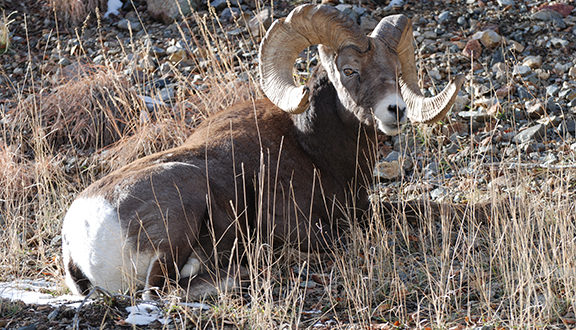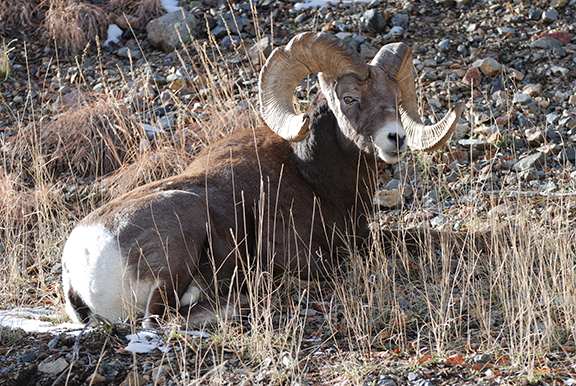Bighorn sheep hunting opportunities are highly coveted throughout North America. Bighorn sheep are not as widespread or abundant as the other big-game species because populations are often restricted to the most rugged habitats. New Mexico offers the opportunity to hunt both desert bighorn sheep and Rocky Mountain bighorn sheep subspecies and success rates average between 90-100%. The availability of a limited number of ewe licenses provides another pathway to hunt this unique and incredible animal. Hunters who draw a bighorn sheep license, and their hunting party, consider it to be a pinnacle hunting experience in their lifetimes. Below is the 2023-2024 bighorn sheep hunting forecast presented by bighorn sheep herd:
Pecos
Type: Alpine (>12,000 ft); Difficulty: High; Trophy Potential: High; Population estimate: 380-420
The Pecos bighorn sheep continue to thrive and consistently boast strong bighorn hunting opportunity in terms of both quality and quantity. They reside primarily on U.S. Forest Service lands, but access is difficult as the trails commonly used to travel into their habitat average 5-10 miles.
Wheeler
Type: Alpine (>12,000 ft); Difficulty: High; Trophy Potential: High; Population estimate: 230-275
The Wheeler bighorn sheep population is one of the most iconic in New Mexico and is well-known across the west. This population recently experienced a respiratory disease event. While the summer survey resulted in high numbers of bighorn sheep observed, the impact on the mature ram cohorts for the 2023-2024 season is yet to be seen. Tags were decreased modestly to hedge any change in ram availability during this timeframe.
Latir
Type: Alpine (>12,000 ft); Difficulty: High; Trophy Potential: High; Population Estimate: 65-80
Due to its smaller population size, the Latirs sometimes get overlooked by applicants. The smaller population corresponds with reduced range size compared to other alpine herds, which serves to focus hunting efforts. A lower number of hunters minimizes the potential for hunter overlap.
Rio Grande Gorge
Type: Low elevation/canyon; Difficulty: Medium; Trophy Potential: High; Population estimate: 225-275
Public land (Bureau of Land Management and U.S. Forest Service) along the rim of the Rio Grande Gorge is more accessible that the alpine herds. Bighorn sheep also occur in, and may quickly transition to, the less-accessible habitat within the gorge corridor or onto habitat that cannot be hunted, such as Taos Pueblo, Orilla Verde, Taos Valley Overlook and portions of the Wild Rivers or on private lands. This herd tends to be less wary of people due to the high volume of visitors to the area.
Dry Cimarron
Type: Low elevation; Difficulty: Low; Trophy Potential: Medium/High; Population estimate: 155-175
Bighorn sheep occur primarily on private land in this unit. Three ranches collectively provide the core habitat for this population and grant access to any public hunters that draw these tags. The longer timeframe on this hunt provides flexibility in timing for all parties.
San Francisco River/Turkey Creek
Type: Low elevation/canyon; Difficulty: High; Trophy Potential: Medium; Population estimate: 50-70
The last survey of this population was in 2021. Bighorn sheep groups can be sporadic in these units, but they still have some reliable habitat strongholds. In addition to bighorn sheep counted in New Mexico during helicopter surveys, rams from neighboring Arizona have been known to venture into these units and may be present at any time.
Ladron
Type: Desert mountain; Difficulty: Medium/High; Trophy Potential: High; Population estimate: 185-215
The Ladron herd has produced some of the largest desert bighorn sheep rams ever harvested in New Mexico and the world. Bighorn sheep can be found in Game Management Unit (GMU) 17 south of U.S. Highway 60, but they occur most often in the mountainous areas ranging from Socorro to Riley Springs in GMU 13.
Fra Cristobal
Type: Desert mountain; Difficulty: Medium; Trophy Potential: Low; Population Estimate: 160-180
This hunt occurs on the privately-owned Armendaris Ranch; thus, bighorn sheep hunters basically have the mountain to themselves. Rams harvested here tend to have smaller horn size. Road access around this mountain is better than most desert bighorn sheep mountain ranges.
Caballos
Type: Desert mountain; Difficulty: Medium/High; Trophy Potential: Medium; Population Estimate: 175-205
The Caballo bighorn sheep population supports significant hunting opportunity. Hunters have had success finding bighorn sheep from Red House Mountain to Palomas Gap and in the sporadic rugged hills in between. The most recent survey in June 2022 yielded the highest number of mature (Class III and Class IV) rams ever observed in this herd.
San Andres
Type: Desert mountain; Difficulty: High; Trophy Potential: Medium/High; Population Estimate: 190-230
The San Andres bighorn sheep reside within the White Sands Missile Range (WSMR). This mountain range is extensive and highly complex, but hunters typically receive some guidance from WSMR personnel or New Mexico Department of Game and Fish escorts. The trophy outlook is typically high, but this can be impacted by ram distribution and accessibility.
Little Hatchets
Type: Desert mountain; Difficulty: Low/Medium; Trophy Potential: Medium/High; Population Estimate: 45-65
The Little Hatchets may be the most accessible desert bighorn sheep range but still provide a true mountain hunt. The count was lower last year; however, mature rams were observed and are consistently present.
Big Hatchets
Type: Desert mountain; Difficulty: High; Trophy Potential: High; Population Estimate: 85-115
The Big Hatchets are one of the most stunning desert ranges in New Mexico and certainly live up to their name. The newly established Alamo Hueco bighorn sheep population also resides in this hunt unit, although ram number and size will likely be low until this herd becomes established. This area is very remote and vast and the hunt is difficult. The incredible habitat allows rams to slip by hunters each year, so trophy potential is high.
Peloncillos
Type: Desert mountain; Difficulty: Medium/High; Trophy Potential: Medium/High; Population Estimate: 120-140
This herd appears to have declined from a few years ago, but hunters continue to harvest record-book rams every year. The topography is somewhat diverse, with some very steep areas neighbored by rolling hills.
 New Mexico Wildlife magazine Conserving New Mexico's Wildlife for Future Generations
New Mexico Wildlife magazine Conserving New Mexico's Wildlife for Future Generations


